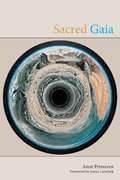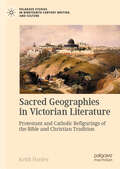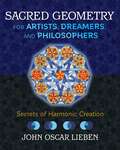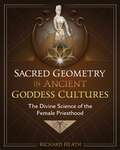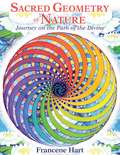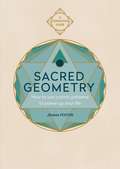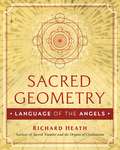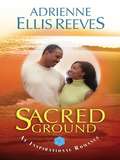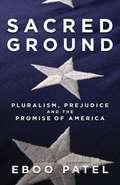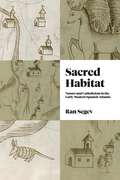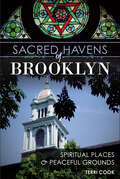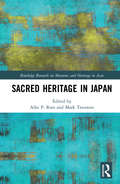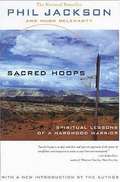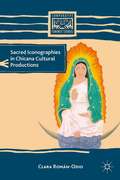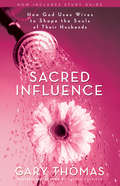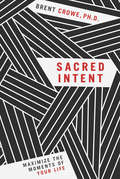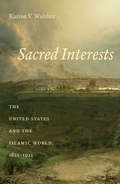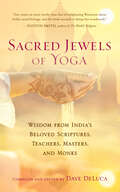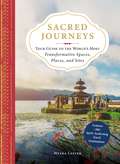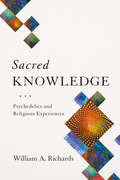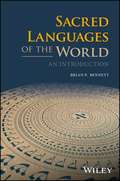- Table View
- List View
Sacred Gaia: Holistic Theology and Earth System Science
by Anne PrimavesiGaia, the scientific theory founded by James Lovelock in 1979, embraces the earth as a whole, dynamic entity whose sum is always larger than its parts. While science and theology are often seen as contraries, which negate or dilute one another, Gaia theory harmonizes both systems of thought. Sacred Gaia cogently describes Gaia theory's analysis of human and earthly evolution. Anne Primavesi's remarkable, effortlessly coherent book helps us to recognize the sacredness of our origins and our responsibility for the future.
Sacred Geographies in Victorian Literature: Protestant and Catholic Refigurings of the Bible and Christian Tradition (Palgrave Studies in Nineteenth-Century Writing and Culture)
by Keith HanleyThis book describes how Christian sacred geographies were represented in Victorian literature. It demonstrates first how those from the Hebrew Bible and the Old and New Testaments had become politically domesticated and psychologically internalised to sustain the Victorian Protestant imaginary in art and literature. It then examines how, following the relocation of the centre of Christendom from Jerusalem to Rome in the Middle Ages, the geographical axis between Rome and Britain had been disrupted during the period of Catholic penalisation but was restored by Emancipation and conversion in the nineteenth century. As a result of these national relocations, a literary atlas of sacred heterotopias, other worlds, was mapped by Protestant and Catholic writers within their industrial-imperialist period. Intended for a primary readership of academics and researchers in the field of Victorian Literature, Religious Studies and History, it focuses on the works of nine writers in a variety of genres, including poetry, novels, art criticism, and historical, literary and theological essays.
Sacred Geometry for Artists, Dreamers, and Philosophers: Secrets of Harmonic Creation
by John Oscar LiebenAn illustrated guide to harmonics--the sacred geometry principles that underlie the natural world--and its practical applications • Demonstrates how the vesica piscis is a matrix from which ideas and forms emanate, connecting cosmic time cycles, measures of space, and musical tones • Provides harmonic analyses of ancient sculpture, architecture, the solar system, the Earth-Moon relationship, and the structure of water and waves • Explains how to apply sacred geometry to create building floor plans, pottery figures, gardens, and sacred ceremonial spaces We are in the midst of a revival of an ancient way of looking at the world--an approach that enabled great civilizations of the past to bring forth inventions of great beauty and power. This school of thought--harmonics--envisioned the natural world and the solar system as an interlocking matrix of harmonious numbers, perfectly woven into the creative fabric of life and the surrounding universe. Exploring the art and science of harmonics, John Oscar Lieben shows how to create harmonious forms using the ancient tools of number, geometry, and musical tone--an approach that resonates with nature’s own ways of creation. He demonstrates many practical applications that result from the study of harmonics, providing analyses of ancient sculpture and architecture, as well as original examples of building floor plans, pottery figures based on planetary proportions, gardens based on harmonic principles, and ceremonial spaces that honor cosmic harmonies and sacred geometric relationships. Showing how harmonics can also be applied to the mysteries of time and space, the author demonstrates how the vesica piscis and many other variations of the vesica shape reveal numerical synchronicities and correspondences that connect cosmic time cycles, measures of space, and musical tones. The author applies harmonics and the “vesica construction” matrix to illustrate many of nature’s wonders, including the Earth-Moon relationship, the interactions of the Golden Number and the musical scale, and how the Flower of Life symbol connects the universal field with the pattern of raindrops falling on a pond. Offering an approach to sacred geometry that pairs the mystical with the practical, the cosmic with the earthly, the author reveals how the art and science of harmonics should be required study for both the artist and the seeker of eternal truths as well as the scientist who seeks an entrance into the sacred foundations of nature.
Sacred Geometry in Ancient Goddess Cultures: The Divine Science of the Female Priesthood
by Richard HeathExamines the ancient cosmic science of the female megalithic astronomers• Describes the shared sacred geometry and astronomy knowledge in the megalithic monuments, temples, and secret calendars of the matrilineal cultures of Malta, Gobekli Tepe, and the Minoans of Crete • Shows how early Christians helped preserve ancient science by encoding it in the rock-cut churches of the Cappadocia region of Turkey • Explains how Greek myths reveal the transition from matriarchy to patriarchy Long before Pythagoras and Plato, before arithmetic and Christianity, there existed matrilineal societies around the Mediterranean, led by women with a sophisticated understanding of astronomy and sacred science. In this detailed exploration, Richard Heath decodes the cosmological secrets hidden by ancient goddess-centered cultures on the island of Malta, at Gobekli Tepe in Turkey, and on the Greek island of Crete. Heath reveals how the female astronomers of Malta built megaliths to study the sun, moon, and planets, counting time as lengths and comparing lengths using geometry. He shows how they encoded their cosmological and astronomical discoveries, their &“astronomy of the goddesses,&” in the geometries of their temples and monuments. Examining Maltese and Cretan artifacts, including secret calendars, he details how the Minoans of Crete transformed Maltese astronomy into a matriarchal religion based upon a Saturnian calendar of 364 days. He also reveals evidence of the precursors of Maltese astronomical knowledge in the monuments of Gobekli Tepe. Looking at the shift from sacred geometry to arithmetic in ancient Mediterranean cultures, the author parallels this change in mindset with the transition from matriarchal to patriarchal cultures. He reveals how Greek myths present a way to see the matriarchal past through patriarchal eyes, detailing how Saturn&’s replacement by Jupiter-Zeus symbolizes the transition from matriarchy to patriarchy. The author examines how the early Christians helped preserve the ancient astronomy of the goddesses, due to its connections to Christ&’s cosmological teachings, by encoding it in the artwork of the rock-cut churches and monasteries of the Cappadocia region of Turkey. Revealing how our planet, with its specific harmonics and geometries within our star system, is uniquely designed to support intelligent life, the author shows how this divine spiritual truth was known to the ancient astronomers.
Sacred Geometry of Nature: Journey on the Path of the Divine
by Francene HartA fully illustrated inspirational art book from visionary painter Francene Hart• Includes more than 80 full-color reproductions of Hart’s intricate watercolor paintings and the stories behind them• Recounts the evolution of her art and her discovery of the hidden order of Nature that led to her masterful artistic integrations of Nature, Spirit, and Sacred Geometry• Explores how to tap into the energies provided by spirit guides and power animals, like Jaguar, Raven, Octopus, and Dolphin, and harness the intelligence of the heart for creative inspiration and visionEvery one of us possesses the potential to receive visionary experiences and integrate them into our lives. Artists become visionaries by cultivating their instinctive creative spark and sharing their profound visions with the world.In this lavishly illustrated memoir, including more than 80 full-color reproductions of her intricate watercolor paintings and the stories behind them, Francene Hart recounts the evolution of her art from formative influences to her masterful integrations of Nature, Spirit, and Sacred Geometry. Opening with her early work on mandalas and her explorations of the work of Joseph Campbell and C. G. Jung, Hart explains how her first works of art were in response to the solitary life she led in the forest, where she discovered the hidden order of Nature. She reveals how she learned to center her artistic explorations on the intelligence of the heart rather than the intellect, utilizing the wisdom and imagery of Sacred Geometry, reverence for the natural environment, and the interconnectedness between all things as her inspirations. She describes the shamanic lessons that accompanied her discoveries and shaped her understanding of sacred relationships with the self, others, and Mother Earth. She explores how to tap into the energies provided by spirit guides and power animals, like Jaguar, Raven, Octopus, and Dolphin, and explains her profound affinity for the ocean, including her discovery of water consciousness in Hawaii. Offering chronicles of her inspiring travels and transformational encounters around the world, Hart shares her experiences at sacred sites in the Amazon, Central America, Egypt, England, Scotland, Paris, Cambodia, and the Himalayas and how these places influenced her art.Exploring what is revealed as inspiration arises, Spirit informs, and vision is transformed into art, Francene Hart’s journey offers a window into the secret order of Nature, the power of sacred symbols for evolving consciousness, and a visionary artistic path that perfectly blends the mathematical rigors of sacred geometry and the numinous.
Sacred Geometry: How to use cosmic patterns to power up your life
by Jemma FosterSacred Geometry exists all around us in the natural world, from the unfurling of a rose bud to the pattern of a tortoise shell, the sub-atomic to the galactic. A pure expression of number and form, it is the language of creation and navigates the unseen dimensions beyond our three-dimensional reality.Since its discovery, humans have found many ways - stone circles, mandalas, labyrinths, temples- to call upon this universal law as a way of raising consciousness and communicating with a divine source. By becoming aware of the dots and lines that build the world around you, Sacred Geometry will teach you how to bring this mystical knowledge into your daily practice.
Sacred Geometry: How to use cosmic patterns to power up your life
by Jemma FosterSacred Geometry exists all around us in the natural world, from the unfurling of a rose bud to the pattern of a tortoise shell, the sub-atomic to the galactic. A pure expression of number and form, it is the language of creation and navigates the unseen dimensions beyond our three-dimensional reality.Since its discovery, humans have found many ways - stone circles, mandalas, labyrinths, temples- to call upon this universal law as a way of raising consciousness and communicating with a divine source. By becoming aware of the dots and lines that build the world around you, Sacred Geometry will teach you how to bring this mystical knowledge into your daily practice.
Sacred Geometry: Sacred Geometry In The Realm Of The Planets
by Richard HeathReveals how the number science found in ancient sacred monuments reflects wisdom transmitted from the angelic orders • Explains how the angels transmitted megalithic science to early humans to further our conscious development • Decodes the angelic science hidden in a wide range of monuments, including Carnac in Brittany, the Great Pyramid in Egypt, early Christian pavements, the Hagia Sophia in Istanbul, Stonehenge in England, and the Kaaba in Mecca • Explores how the number science behind ancient monuments gave rise to religions and spiritual practices The angelic mind is founded on a deep understanding of number and the patterns they produce. These patterns provided a constructive framework for all manifested life on Earth. The beauty and elegance we see in sacred geometry and in structures built according to those proportions are the language of the angels still speaking to us. Examining the angelic science of number first manifested on Earth in the Stone Age, Richard Heath reveals how the resulting development of human consciousness was no accident: just as the angels helped create the Earth&’s environment, humans were then evolved to make the planet self-aware. To develop human minds, the angels transmitted their own wisdom to humanity through a numerical astronomy that counted planetary and lunar time periods. Heath explores how this early humanity developed an expert understanding of sacred number through astronomical geometries, leading to the unified range of measures employed in their observatories and later in cosmological monuments such as the Giza Pyramids and Stonehenge. The ancient Near East transformed megalithic science into our own mathematics of notational arithmetic and trigonometry, further developing the human mind within the early civilizations. Heath decodes the angelic science hidden within a wide range of monuments and sites, including Carnac in Brittany, the Great Pyramid in Egypt, Teotihuacan in Mexico, early Christian pavements, the Hagia Sophia in Istanbul, and the Kaaba in Mecca. Exploring the techniques used to design these monuments, he explains how the number science behind them gave rise to ancient religions and spiritual practices. He also explores the importance of lunar astronomy, first in defining a world suitable for life and then in providing a subject accessible to pre-arithmetic humans, for whom the Moon was a constant companion.
Sacred Ground
by Adrienne Ellis ReevesMakima Gray has prayed for guidance in building her town's new medical clinic, and she's sure that Gabriel Bell's property is the perfect location. Gabe insists he's not at liberty to sell, but Makima won't give up. . . nor can she deny that she's flattered by Gabe's attentions. But past hurts and present complications lead to an error in judgment that may drive Gabe away forever. Gabriel Bell was astonished to inherit his great-grandfather's land, along with clues to a mysterious treasure. But every second he spends with beautiful, determined Makima convinces him that winning her trust -and her heart - is the most important quest of all.
Sacred Ground: Pluralism, Prejudice, and the Promise of America
by Eboo PatelThere is no better time to stand up for your values than when they are under attack. In the decade following the attacks of 9/11, suspicion and animosity toward American Muslims has increased rather than subsided. Alarmist, hateful rhetoric once relegated to the fringes of political discourse has now become frighteningly mainstream, with pundits and politicians routinely invoking the specter of Islam as a menacing, deeply anti-American force. In Sacred Ground, author and renowned interfaith leader Eboo Patel says this prejudice is not just a problem for Muslims but a challenge to the very idea of America. Patel shows us that Americans from George Washington to Martin Luther King Jr. have been "interfaith leaders," illustrating how the forces of pluralism in America have time and again defeated the forces of prejudice. And now a new generation needs to rise up and confront the anti-Muslim prejudice of our era. To this end, Patel offers a primer in the art and science of interfaith work, bringing to life the growing body of research on how faith can be a bridge of cooperation rather than a barrier of division and sharing stories from the frontlines of interfaith activism. Patel asks us to share in his vision of a better America--a robustly pluralistic country in which our commonalities are more important than our differences, and in which difference enriches, rather than threatens, our religious traditions. Pluralism, Patel boldly argues, is at the heart of the American project, and this visionary book will inspire Americans of all faiths to make this country a place where diverse traditions can thrive side by side.From the Hardcover edition.
Sacred Habitat: Nature and Catholicism in the Early Modern Spanish Atlantic (Iberian Encounter and Exchange, 475–1755)
by Ran SegevKnown as a time of revolutions in science, the early modern era in Europe was characterized by the emergence of new disciplines and ways of thinking. Taking this conceit a step further, Sacred Habitat shows how Spanish friars and missionaries used new scholarly approaches, methods, and empirical data from their studies of ecology to promote Catholic goals and incorporate American nature into centuries-old church traditions.Ran Segev examines the interrelated connections between Catholicism and geography, cosmography, and natural history—fields of study that gained particular prominence during the sixteenth and seventeenth centuries—and shows how these new bodies of knowledge provided innovative ways of conceptualizing and transmitting religious ideologies in the post-Reformation era. Weaving together historical narratives on Spain and its colonies with scholarship on the Catholic Reformation, Atlantic science, and environmental history, Segev contends that knowledge about American nature allowed pious Catholics to reconnect with their religious traditions and enabled them to apply their beliefs to a foreign land.Sacred Habitat presents a fresh perspective on Catholic renewal. Scholars of religion and historians of Spain, colonial Latin America, and early modern science will welcome this provocative intervention in the history of empire, science, knowledge, and early modern Catholicism.
Sacred Havens of Brooklyn: Spiritual Places and Peaceful Grounds (Landmarks)
by Terri CookDuring the nineteenth century, Brooklyn earned the nickname "Borough of Churches" as thousands settled here and brought their beliefs with them. Spirituality has always been a major part of life for Brooklynites. Peter Stuyvesant established the Flatbush Dutch Church in 1654, and freed slaves worshipped in their sanctuaries since 1766. Fatih Mosque calls Moslems to prayer five times a day, Dorje Ling Buddhist temple fills visitors with peace, and more than 150 temples minister to many branches of Judaism. Spirituality is also visible in historic sites and monuments, from Fort Greene Park's Revolutionary War memorial to a Japanese shrine in Botanic Gardens. Discover some of the more than two thousand havens that have overflowed with people who were determined to prevail in faith and hope in New York's most populous borough.
Sacred Heritage in Japan (Routledge Research on Museums and Heritage in Asia)
by Mark Teeuwen Aike P. RotsSacred Heritage in Japan is the first volume to explicitly address the topics of Japanese religion and heritage preservation in connection with each other. The book examines what happens when places of worship and ritual practices are rebranded as national culture. It also considers the impact of being designated tangible or intangible cultural properties and, more recently, as UNESCO World or Intangible Heritage. Drawing on primary ethnographic and historical research, the contributions to this volume show the variety of ways in which different actors have contributed to, negotiated, and at times resisted the transformation of religious traditions into heritage. They analyse the conflicts that emerge about questions of signification and authority during these processes of transformation. The book provides important new perspectives on the local implications of UNESCO listings in the Japanese context and showcases the diversity of "sacred heritage" in present-day Japan. Combining perspectives from heritage studies, Japanese studies, religious studies, history, and social anthropology, the volume will be of interest to scholars and students who want to learn more about the diversity of local responses to heritage conservation in non-Western societies. It will also be of interest to scholars and students engaged in the study of Japanese religion, society, or cultural policies.
Sacred History and National Identity: Comparisons Between Early Modern Wales and Brittany (Religious Cultures in the Early Modern World #4)
by Jason NiceThe late sixteenth century saw a redrawing of the borders of north-west Europe. Wales and Brittany entered into unions with neighboring countries England and France. This book uses Brittany and Wales' responses to unification to describe a comparative history of national identity during the early modern period.
Sacred Hoops: Spiritual Lessons of a Hardwood Warrior
by Phil Jackson Hugh DelehantyAn inside look at the higher wisdom of teamwork from Chicago Bulls' head coach Phil Jackson. At the heart of the book is Jackson's philosophy of mindful basketball -- and his lifelong quest to bring enlightenment to the competitive world of professional sports, beginning with a focus on selfless team play rather than "winning through intimidation".
Sacred Humanism without Miracles: Responding to the New Atheists
by Roy G. SaltmanThe New Atheists' claim that religion always leads to fanaticism is baseless. State-backed religion results in tyranny. Sacred humanists work to implement their highest values that will improve this world; separation of church and state, eliminating denigration of nonbelievers, assuring just governance, and preventing human trafficking.
Sacred Iconographies in Chicana Cultural Productions (Comparative Feminist Studies)
by Clara Román-OdioThis book examines the iconography of the Virgin of Guadalupe as a force for social justice and feminist emancipation within Chicana cultural productions from 1975-2010. In these productions the Virgin serves as a paradigm to unlock the histories of conquest and colonization, racism, and sexual oppression in the US-Mexico borderland and beyond.
Sacred Influence
by Gary ThomasGod calls women to influence and move their husbands in positive ways. Applying the concepts from his bestseller, Sacred Marriage, Gary Thomas offers a view through a man's eyes. Here's the inside scoop on what men find motivating-with inspiring real-life stories of women who are employing this knowledge to transform their marriages. Sacred Influence doesn't flinch from difficult marital problems. But by using this faith-focused approach, you'll see how to help your husband become the man God intends him to be. At the same time, God will shape you to be the woman he designed you to be. God has given godly women a wonderful power to influence and encourage their husbands. What's the secret? This book will provide challenges, examples, and hope to women who want to love their husbands well and be loved well in return. --Dennis Rainey, President of Family Life
Sacred Intent: Maximize the Moments of Your Life
by Brent CroweCrowe speaks to tens of thousands each year, instilling leadership skills and motivating his audience to imagine what you would do for the glory of God, if you knew with certainty that you absolutely could not fail.
Sacred Interests: The United States and the Islamic World, 1821-1921
by Karine WaltherThroughout the nineteenth and early twentieth centuries, as Americans increasingly came into contact with the Islamic world, U.S. diplomatic, cultural, political, and religious beliefs about Islam began to shape their responses to world events. In Sacred Interests, Karine V. Walther excavates the deep history of American Islamophobia, showing how negative perceptions of Islam and Muslims shaped U.S. foreign relations from the Early Republic to the end of World War I. Beginning with the Greek War of Independence in 1821, Walther illuminates reactions to and involvement in the breakup of the Ottoman Empire, the efforts to protect Jews from Muslim authorities in Morocco, American colonial policies in the Philippines, and American attempts to aid Christians during the Armenian Genocide. Walther examines the American role in the peace negotiations after World War I, support for the Balfour Declaration, and the establishment of the mandate system in the Middle East. The result is a vital exploration of the crucial role the United States played in the Islamic world during the long nineteenth century--an interaction that shaped a historical legacy that remains with us today.
Sacred Jewels of Yoga: Wisdom from India's Beloved Scriptures, Teachers, Masters, and Monks
by Dave DeLucaMillions of Americans today practice the asanas, or postures, of yoga, but many are unaware of the profound spiritual teachings at the heart of yoga’s ancient source scriptures. In this remarkable anthology, acclaimed Vedanta teacher Dave DeLuca presents 166 sacred passages from some of India’s most revered yoga scriptures — the Upanishads, the Bhagavad Gita, the Yoga Sutras, the Bhakti Sutras, the Astavakra Samhita, and the Srimad Bhagavatam — along with teachings by two of the most beloved yoga masters of the modern era, Sri Ramakrishna and Swami Vivekananda. This combination of ancient wisdom and modern commentary makes Sacred Jewels of Yoga an invaluable introduction to the scriptural treasures of ancient India and a priceless resource for inspiration, illumination, and guidance.
Sacred Journeys: Your Guide to the World's Most Transformative Spaces, Places, and Sites
by Meera LesterA guide to 200 sacred, spirit-awakening, and restorative destinations—as well as inspiring quotes, key travel information, and special healing exercises to complete at each location—to start your journey to spiritual wellness.There’s power in places! From Sedona, Lourdes, or even Tulum, this wellness-focused guide will show you the best sites to visit to get in touch with your spiritual side. Find inspiration with quotes from renowned spiritual leaders, enjoy full-color photos to help you prepare your travel wish list, learn more about legendary locations around the world, and start planning your next trip today. Mourn a lost love—or celebrate a new one—at the Taj Mahal, summon strength from the mountains on Machu Picchu, and uncover the fortitude to make your dreams come true at the Bighorn Medicine Wheel—and much more! Discover the perfect trip for every circumstance, or just travel to unwind and reconnect with yourself. With healing wellness activities to complete at each location, this guide is the perfect way to jumpstart your spiritual travels and seek out a unique and transformative experience.
Sacred Kingship in World History: Between Immanence and Transcendence
by Moin, A. Azfar; Strathern, AlanSacred kingship has been the core political form, in small-scale societies and in vast empires, for much of world history. This collaborative and interdisciplinary book recasts the relationship between religion and politics by exploring this institution in long-term and global comparative perspective.Editors A. Azfar Moin and Alan Strathern present a theoretical framework for understanding sacred kingship, which leading scholars reflect on and respond to in a series of essays. They distinguish between two separate but complementary religious tendencies, immanentism and transcendentalism, which mold kings into divinized or righteous rulers, respectively. Whereas immanence demands priestly and cosmic rites from kings to sustain the flourishing of life, transcendence turns the focus to salvation and subordinates rulers to higher ethical objectives. Secular modernity does not end the struggle between immanence and transcendence—flourishing and righteousness—but only displaces it from kings onto nations and individuals. After an essay by Marshall Sahlins that ranges from the Pacific to the Arctic, the book contains chapters on religion and kingship in settings as far-flung as ancient Egypt, classical Greece, medieval Islam, Mughal India, modern European drama, and ISIS. Sacred Kingship in World History sheds new light on how religion has constructed rulership, with implications spanning global history, religious studies, political theory, and anthropology.
Sacred Knowledge: Psychedelics and Religious Experiences
by William RichardsSacred Knowledge is the first well-documented, sophisticated account of the effect of psychedelics on biological processes, human consciousness, and revelatory religious experiences. Based on nearly three decades of legal research with volunteers, William A. Richards argues that, if used responsibly and legally, psychedelics have the potential to assuage suffering and constructively affect the quality of human life.Richards's analysis contributes to social and political debates over the responsible integration of psychedelic substances into modern society. His book serves as an invaluable resource for readers who, whether spontaneously or with the facilitation of psychedelics, have encountered meaningful, inspiring, or even disturbing states of consciousness and seek clarity about their experiences. Testing the limits of language and conceptual frameworks, Richards makes the most of experiential phenomena that stretch our understanding of reality, advancing new frontiers in the study of belief, spiritual awakening, psychiatric treatment, and social well-being. His findings enrich humanities and scientific scholarship, expanding work in philosophy, anthropology, theology, and religious studies and bringing depth to research in mental health, psychotherapy, and psychopharmacology.
Sacred Languages of the World: An Introduction
by Brian P. BennettA fascinating comparative account of sacred languages and their role in and beyond religion —written for a broad, interdisciplinary audience Sacred languages have been used for foundational texts, liturgy, and ritual for millennia, and many have remained virtually unchanged through the centuries. While the vital relationship between language and religion has been long acknowledged, new research and thinking across an array of disciplines including religious studies, sociolinguistics, sociology, linguistics, and even neurolinguistics has resulted in a renewed interest in the area. This fascinating and informative book draws on Christian, Islamic, Hindu, Judaic, and Buddhist traditions to provide a concise and accessible introduction to the phenomenon of sacred languages. The book takes a strongly comparative, wide-ranging approach to exploring ways in which ancient religious languages, such as Latin, Pali, Church Slavonic, and Hebrew continue to shape the beliefs and practices of religious communities around the world. Informed by both comparative religion and sociolinguistics, it traces the histories of sacred languages, the myths and doctrines that explain their origin and value, the various ways they are used, the sectarian debates that shadow them, and the technological innovations that propel them forward in the twenty-first century. A comprehensive but succinct account of the role and importance of language within religion Takes an interdisciplinary approach which will appeal to students and scholars across an array of disciplines, including religious studies, sociology of religion, sociolinguistics, and linguistics Provides a strongly comparative exploration, drawing on Christian, Islamic, Hindu, Judaic, and Buddhist traditions Uses numerous examples and ties historic debates with contemporary situations Satisfies the rapidly growing demand for books on the subject among both academics and general readers Sacred Languages of the World is a must-read for students of religion and language, scripture, religious literacy, education and language, the sociology of religion, sociolinguistics. It will also have strong appeal among general readers with an interest comparative religion, history, cultural criticism, communication studies, and more.
